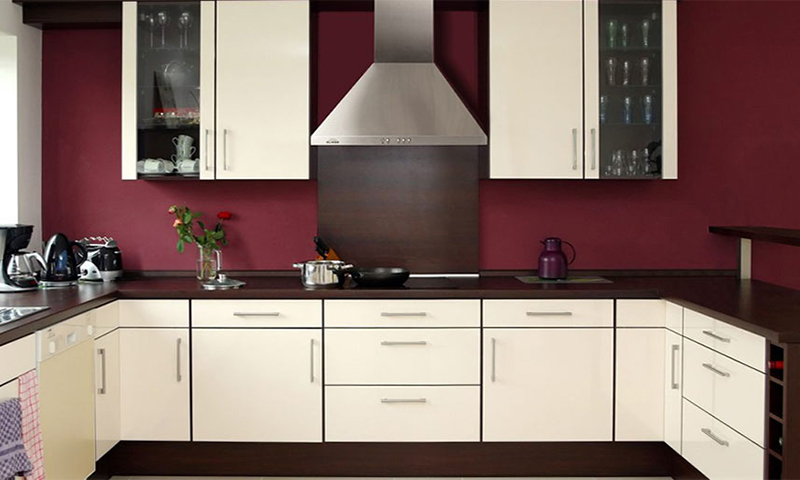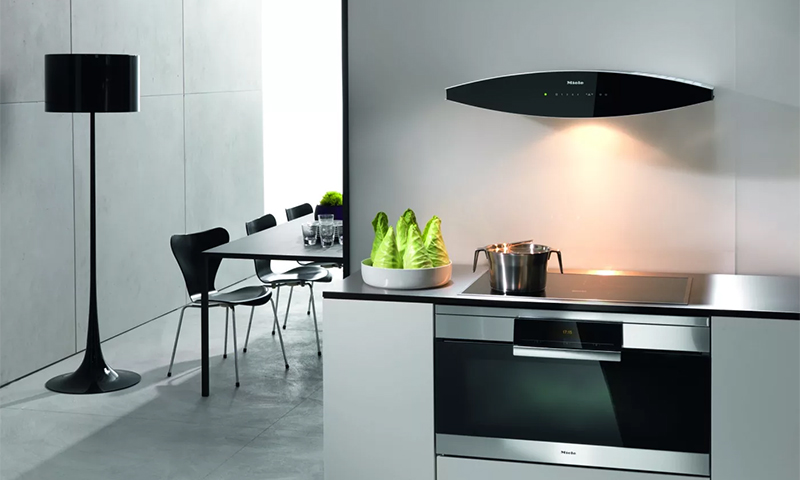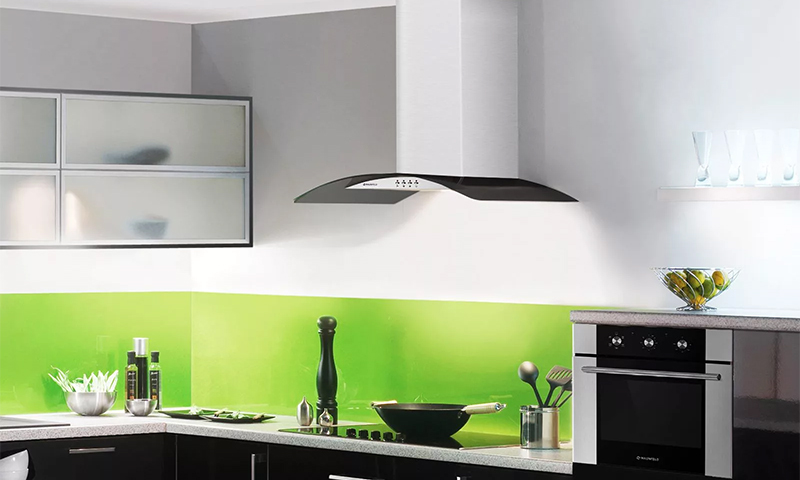Modern kitchen can not be imagined without a hood. This indispensable device not only cleans the room from odors, steam and gas soot, but also prolongs the life of kitchen furniture, protecting it from the appearance of greasy deposits. The device should fit perfectly into the interior, but do not focus only on the appearance of the hood. It is important that it has good characteristics - sufficient to effectively update the air in the kitchen.

Content:
The best manufacturers of kitchen hoods - which company to choose
Many well-known brands of home appliances are engaged in the production of kitchen hoods, and they are quite widely represented in our market. In terms of the number of positive customer reviews, specifications, ease of use and service life, the leaders in this segment are devices of the following brands:
- Bosch
- Maunfeld
- Gorenje
- Asko
- Ardesia
Also read the detailed top hoods rating these manufacturers. In the meantime, let's figure out how to choose the right technique for your kitchen.
The principle of operation and the device kitchen hood
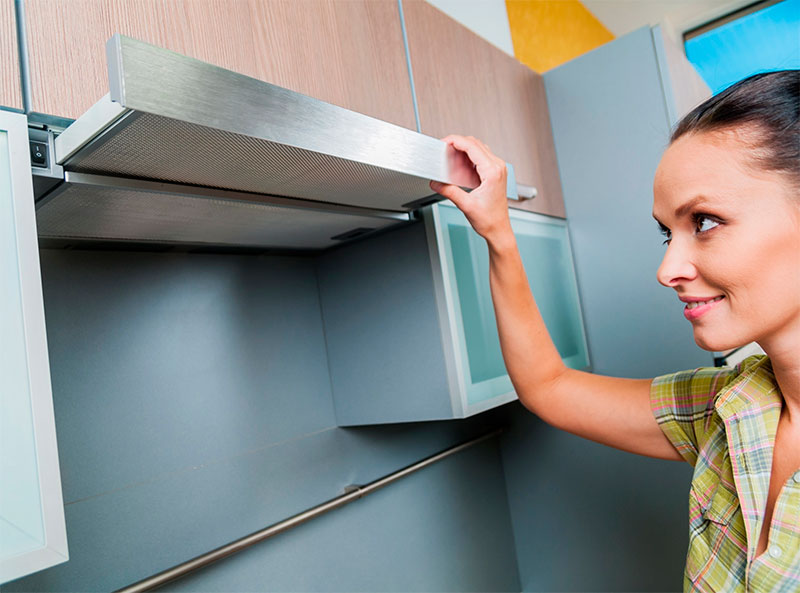
Exhaust umbrella - a device that catches and removes the steam, children and smells of food formed during cooking. The engine of the mechanism starts the fan, which draws in polluted air, drives it through the filter system and leads it into the ventilation pipe or returns it back to the room.
The classical device of forced ventilation of air consists of the following elements:
- Housing with a wide bell;
- Grease grids;
- Additional cleaning filters or vent;
- Electric motor with fan;
- Control block;
- Built-in lighting.
However, the principle of operation of the hood may differ slightly, depending on the air discharge scheme implemented in it.
Flow models pull steam and odors through a special duct (corrugated pipe, plastic or metal box) into the ventilation shaft of the house. Alternatively, the exhaust air can be discharged through a hole in the wall directly to the street.
These hoods are effective and in great demand because of the relative cheapness, high performance and durability. However, it is problematic to integrate such a device into an already finished interior, because the installation of the unit must be foreseen in advance - at the kitchen repair stage.
Recirculation units pass air through themselves, cleaning it with the help of a system of grease traps and carbon filters, and returns it back to the room. The main advantage of such range hoods is the simplicity of their installation at any point of the kitchen and relative compactness. Among the disadvantages are lower efficiency (-30% of the flow characteristics) and the need to regularly change the filters.
Combined (universal) hoods combine the advantages of the two previous types - the desired mode of operation is simply set by a switch. For cleansing the air at the time of intensive cooking, you can use a flow system, in other cases there will be enough recycling.
Now, many manufacturers are focusing on universal hoods, as the most functional and comfortable for everyone.
Types of hoods
In addition to the already considered classification of air drafts according to the principle of air discharge, there is a more traditional division of this technique - according to the type of construction.
Suspended
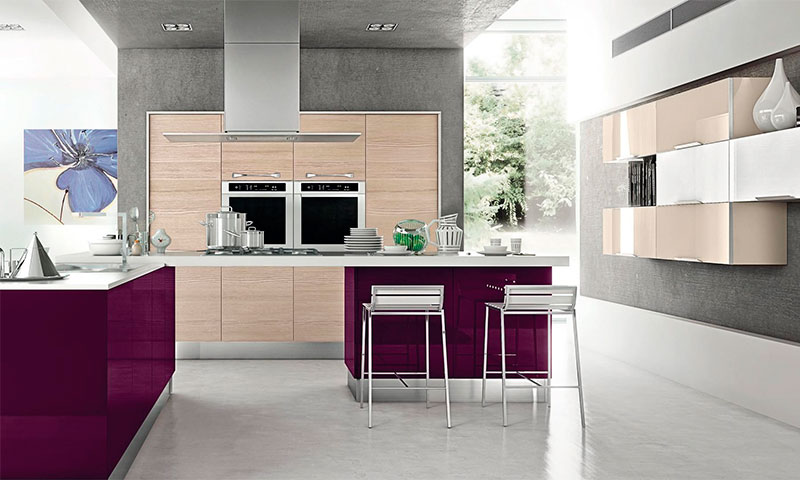
Flat suspended models simply fasten to the wall above the stove and do not interfere with the installation of the top cabinet. As a rule, these are combined units, which, if desired, can be connected to ventilation.
Pros:
- Compact size;
- Easy installation;
- Suitable for any modern interior;
- The top cover can be used to store kitchen small things;
- Affordable price.
Minuses:
- Requires regular replacement of filter cartridges;
- Low productivity;
- Narrow lineup.
Embedded
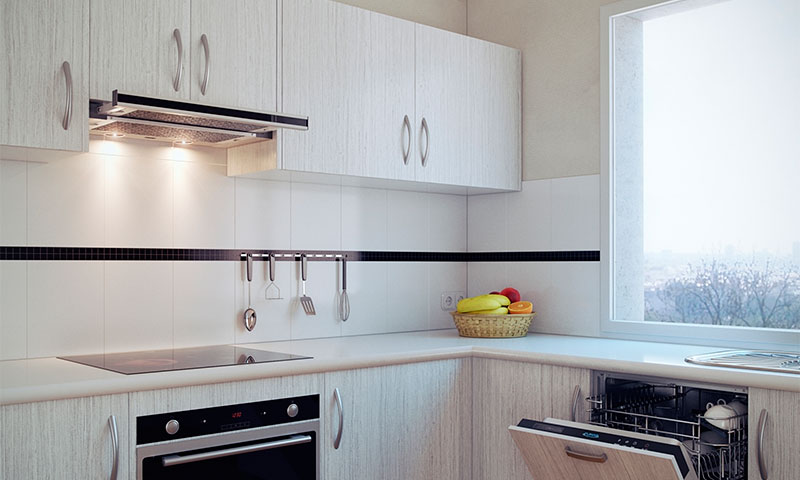
Such hoods are increasingly in demand among buyers, because the hidden technology does not spoil the overall interior and at the same time quietly performs its functions. Embedded models are mounted in a hanging cabinet so that only a narrow strip of the working panel remains in view.
The principle of exhaust air here can be any: recirculation, flow or combined. Among these structures are often found deviating and retractable hoods in which the suction area increases.
Pros:
- Saving space in the kitchen;
- Stealth embedded technology;
- Good air cleaning efficiency;
- Quite quiet work.
Minuses:
- Low power.
Dome (chimney)

They got their name for the similarity with the truncated cone of the classic chimney arch. Initially, it was quite overall devices, but today manufacturers produce a lot of T-shaped island, as well as inclined hoods, which are also domed, although outwardly different from their predecessors.
All fireplace models operate on the principle of complete air discharge, although expensive appliances are additionally equipped with a recirculation function. In any case, it is always quite powerful units of high performance. Depending on the shape of the umbrella, appliances can be installed against the wall, in the corner and even under the ceiling.
Pros:
- Effective air cleaning;
- High performance;
- Rich functionality;
- A variety of design solutions and models.
Minuses:
- Bulkiness;
- The need to install a ventilation duct;
- Relatively high cost.
Kitchen hood options
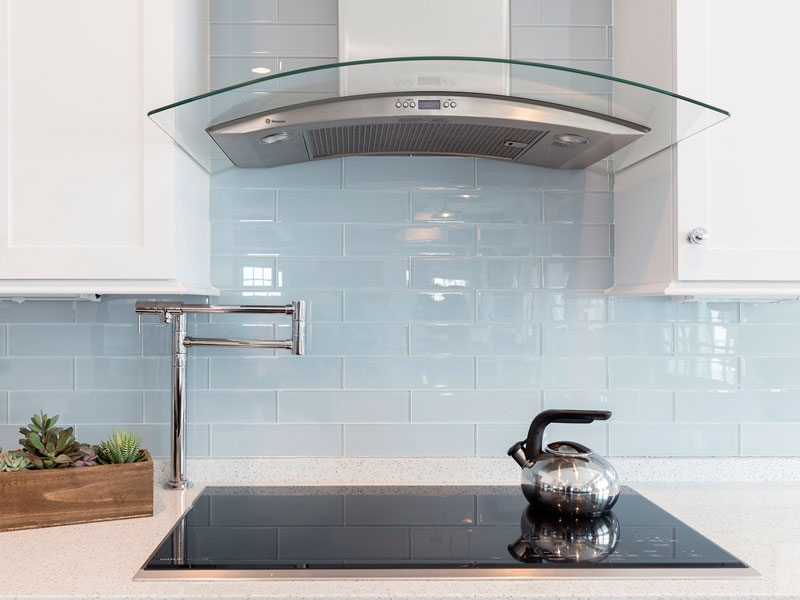
Performance
The main indicator of the efficiency of the device is the volume of air that the device manages to take per unit of time (measured in m3 / h).
To determine which hood is suitable for your kitchen, it is necessary to calculate the cubic capacity of the room and multiply it by 12 - exactly as many times at the request of sanitary standards the air should be updated in 1 hour.
The resulting figure should be multiplied by a safety factor of 1.3, if the duct works for the ventilation shaft, and by 1.1 - if you just need to lay a little more power. This will allow to use the equipment at medium speed without loss of efficiency.
The size
At first glance, the larger the hood, the better. But too cumbersome version hardly decorates the interior, and it also steals a lot of useful space above the stove. Here you need to proceed from the dimensions of the hob - the socket of the kitchen hood must match its width.
For compact three-ring stoves and “dominoes”, a small model of 45 cm is enough; traditional 4-ring stoves are suitable for ventilation with a 60 cm bell. For large panels, 5 or more burners produce hoods from 90 to 120 cm wide
Control method
Modern air purifiers provide two control options: mechanical and electronic. The first is done using buttons or a slider, the second - by a sensor or pseudo-sensor.
Mechanical units are cheaper than their electronic counterparts, but people at the age are much more accustomed to using buttons than insensible sensors. The most heaped up models assume management by means of the remote control.
Body material
From the material of which the air cleaner body is made, the service life and features of care for equipment depend. The main criteria that should be preferred are practicality and durability.
Modern manufacturers offer us the following options:
- Enameled steel is the most unpretentious, easy to clean and inexpensive.
- Stainless steel - it looks stylish and expensive, but requires constant care and all the time "pleases the eye" with fingerprints.
- Plastic is a budget and fairly quiet option, but its service life is much lower than that of metal cases.
- Tempered glass - in the interior looks luxurious and even futuristic, but like stainless steel, it gives a lot of problems in the care.
Filters
Filters in air purifiers install 2 types: grease catcher and fine cleaning.
The first ones are a metal grid on which particles of hot grease from the air “condense”. It is easy to remove and wash, then put it back in place.
Recently, along with such grease catchers, acrylic grids have begun to appear (most often in inclined models), but they cannot be cleaned and require regular replacement.
“Thin” filters containing ground activated carbon are designed to eliminate the smells of food and smoke. This consumables, which requires replacement on average every six months.
Noise level
Noise performance exhaust technology is an important indicator, especially for a small or combined with a residential area of the kitchen. In order not to exceed the allowable values of 40-50 dB, do not use the exhaust hood that is too powerful for your room.
Be sure to check the technical documentation before buying, so as not to run into a loud-voiced assistant, and at the same time ask the store to turn it on at second or third speed.
If you need a powerful model for a large kitchen, look for the unit in a plastic sound-absorbing case or with two motors at once.
Backlight
This function is present in almost all modern hoods, but is not always implemented correctly. Halogen and LED bulbs give the brightest light - they are also the most economical. With this light you will see well the cooking even with the top lights turned off.
Be careful with fluorescent light bulbs - you can easily be mistaken with the real color of dishes, for example, when assessing the degree of roasted meat or pastries. It is better to refuse incandescent lamps at all - they are “voracious” and heat very strongly, which is why plastic ceiling lamps are often melted.
Additional functions
Electronically controlled hoods offer a wide range of useful features. Whether you need them - decide for yourself, because the extra options not only simplify the work with the device, but also significantly increase its cost.
Today the most popular options are:
- Automatic start and shift speeds. The sensor built into the housing responds to the level of air pollution and selects the appropriate mode of operation on its own.
- Filter indicator - will warn about its filling and the need for a quick replacement.
- Residual operation - in this mode the fan will continue to work slowly for another 10-15 minutes after switching off the equipment in order to completely eliminate all odors.
- Interval start - the unit periodically starts itself, updating the air in the kitchen.
- Timer - allows you to set the time for automatic activation or deactivation of the hood.
What hood for the kitchen to choose
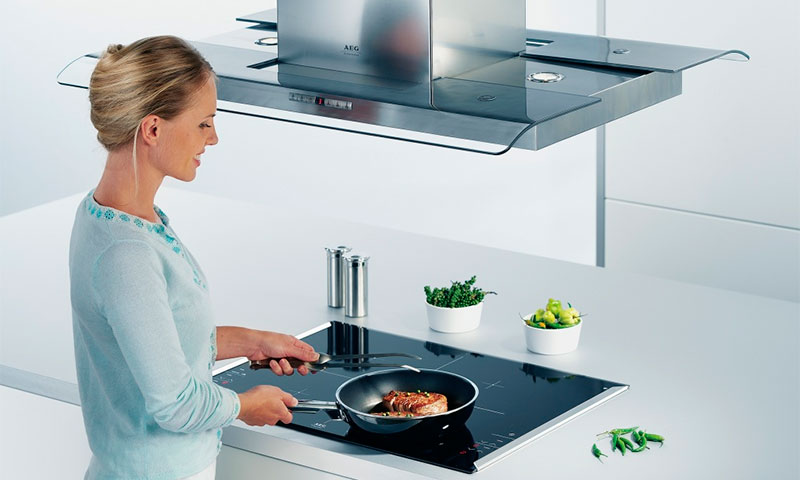
1. In a small kitchen with an area of up to 16 m2 with a stove against the wall and free access to the general ventilation system, suspended or built-in flow hood with a capacity of up to 500 m3 / h is suitable. If you can not make the duct, buy a circulation model.
2. For a medium-sized kitchen up to 28 m2 with a hob near the wall, where it is easy to connect to the ventilation shaft, you can choose a dome hood with full air discharge and a capacity of 500–1000 m3 / h.
3. For a large and spacious kitchen with an area of more than 28 m2 with a cooking area in the center, an island combined extractor with a capacity of at least 900 m3 / h is needed.
The cost of exhaust equipment
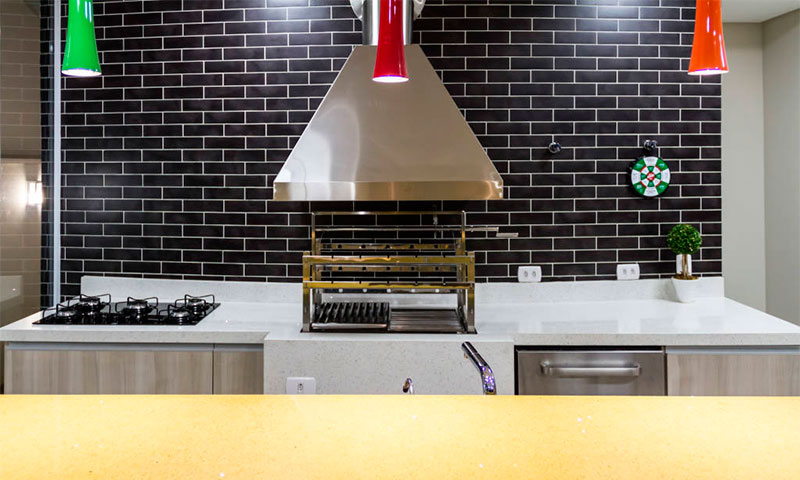
1. Suspended model with mechanical or electronic control can be purchased at a price of from 1700 to 12000 rubles.
2. Dome hood, working only on tap, will cost from 1800 to 28 thousand rubles, the ceiling for the combined model - 150 thousand.
3. The cheapest inclined hood will pull on 3700-4000 rubles, the upper limit reaches 265 thousand.
4. Island models are the most expensive - from 10 to 320 thousand rubles.
5. Embedded technology will not come out cheaper than 2500, the price ceiling is kept at 290–300 thousand rubles.
It will be interesting to friends too

